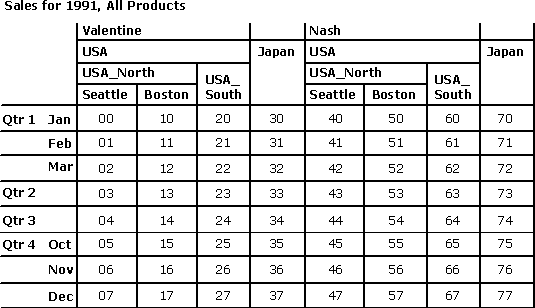Working with Multidimensional Data
A cellset is the result of a query on multidimensional data. It consists of a collection of axes, usually no more than four axes and typically only two or three. An axis is a collection of members from one or more dimensions, which is used to locate or filter specific values in a cube.
A position is a point along an axis. For an axis consisting of a single dimension, these positions are a subset of the dimension members. If an axis consists of more than one dimension, then each position is a compound entity, which has n parts where n is the number of dimensions oriented along that axis. Each part of the position is a member from one constituent dimension.
For example, if the Geography and Product dimensions from a cube containing sales data are oriented along the x-axis of a cellset, a position along this axis may contain the members "USA" and "Computers." In this example, determining a position along the x-axis requires that members from each dimension are oriented along the axis.
A cell is an object positioned at the intersection of axis coordinates. Each cell has multiple pieces of information associated with it, including the data itself, a formatted string (the displayable form of cell data), and the cell ordinal value. (Each cell is a unique ordinal value in the cellset. The ordinal value of the first cell in the cellset is zero, while the leftmost cell in the second row of a cellset with eight columns would have an ordinal value of eight.)
For example, a cube has the following six dimensions (note that this cube schema differs slightly from the example given in Overview of Multidimensional Schemas and Data):
- Salesperson
- Geography (natural hierarchy)—Continents, Countries, States, and so on
- Quarters—Quarters, Months, Days
- Years
- Measures—Sales, PercentChange, BudgetedSales
- Products
The following cellset represents sales for 1991 for all products:

Note The cell values in the example can be viewed as ordered pairs of axis position ordinals where the first digit represents the x-axis position and the second digit the y-axis position.
The characteristics of this cellset are as follows:
- Axis dimensions: Quarters, Salesperson, Geography
- Filter dimensions: Measures, Years, Products
- Two axes: COLUMN (x, or Axis 0) and ROW (y, or Axis 1)
- x-axis: two nested dimensions, Salesperson and Geography
- y-axis: Quarters dimension
The x-axis has two nested dimensions: Salesperson and Geography. From Geography, four members are selected: Seattle, Boston, USA-South, and Japan. Two members are selected from Salesperson: Valentine and Nash. This yields a total of eight positions on this axis (8 = 4*2).
Each coordinate is represented as a position with two members—one from the Salesperson dimension and another from the Geography dimension:
(Valentine, Seattle), (Valentine, Boston), (Valentine, USA_North),
(Valentine, Japan), (Nash, Seattle), (Nash, Boston), (Nash, USA_North),
(Nash, Japan)
The y-axis has only one dimension, containing the following eight positions:
Jan, Feb, Mar, Qtr2, Qtr3, Oct, Nov, Dec
Cellsets, cells, axes, and positions are all represented in ADO MD by corresponding objects: Cellset, Cell, Axis, and Position.